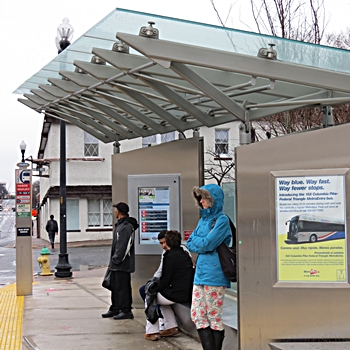Fear not, taxpayers: Arlington bus stops to cost half million each, not $1 million

By Kathryn Watson | Watchdog.org, Virginia Bureau
ALEXANDRIA, Va. — If Arlington County officials’ plan to build a system of 24 bus stops costing $1 million per stop made your blood boil, simmer down.
POSH STOP: Passengers wait outside the $1 million “Super Stop” along Columbia Pike in Arlington in January.
They’ll now only cost half a million each on average — or, almost the median value of a house in the county.
After public outcry compelled a yearlong reconsideration and redesign of the Columbia Pike Transit Stations Project’s “Super Stops,” Arlington County Manager Barbara Donnellan proudly announced this week in a news conference that the county has managed to ratchet down those costs by 40 percent.
Each bus stop, which also will accommodate street cars in the future, will cost only about half a million each, or $12.4 million for the entire project, instead of $20.9 million previously project.
“The prototype cost too much, took too long to build and had design problems we needed to fix,” Donnellan said.
The county should just build houses for people to wait inside instead of bus shelters, one Washington Post reader said in the comments section of a rather aloof article that noted only how much the county is saving without pointing out how much the county is still spending.
And as of January, the county had already spent $10.8 million on the project, with just one shelter to show for it.
The county paid consulting firm Parsons Transportation Group $250,000 to redesign the stops and fix some issues with the one prototype “Super Stop,” which many riders said didn’t protect them from the weather.
But don’t worry. Arlington taxpayers aren’t the only ones footing the bill. County and state taxpayers are getting a share of the action as well. County transportation funds and bonds account for just about one-third of the funding, while state tax dollars are footing 14 percent of the bill. Taxpayers from around the country will carry the other 52 percent of the cost, thanks to federal tax dollars.
It was that level of proposed spending on bus stops and streetcars that last month propelled a non-Democrat Board of Supervisors candidate to victory in Arlington for the first time in 15 years.
“We need to focus spending on core services first — public schools, public safety, infrastructure maintenance and neighborhood quality of life — not a $310 million streetcar (and) million-dollar bus stops,” John Vihstadt, who ran as an independent, said during his campaign.
Asked how county leaders can justify the project’s $12.4 million cost when schools are in need, county spokesman Eric Balliet said most of the funding comes from “dedicated transportation funds.”
“A lot of people, when they hear about the cost and they look at it, they say, well I don’t understand where all the money went,” Balliet said.
For starters, the price tag is high because the platform is 90-feet long and made to fit two buses. The canopy is curbed to make for easier loading and unloading, Balliet said.
The prototype stop also was built with a heated concrete floor and a screen to tell riders when the next bus is scheduled to arrive.
Balliet said the costs are “in line” with other transit systems that serve light rail. County staff pointed to a light rail stop in Hampton Roads that has columns and cost $762,000.
Of course, other no-frills bus stops in Arlington cost just $30,000.
Balliet, however, said the extra cost is worth it to accomplish the county’s two primary goals — accommodating lots of riders and convincing people to travel either on foot or by public transportation.
“We have more than 16,000 transit riders daily,” Balliet said. “And that’s one of the highest bus ridership corridors in the state of Virginia.
“But then, the other purpose is obviously, the county has a larger vision of transforming the Pike into a more transit-oriented, pedestrian-friendly environment. These stations serve that purpose, serve that vision of creating a more walkable, transit-friendly environment that encourages people to use transit.”
At this point, the price tags are nothing more than estimates. The project won’t be put up for bid until later this year.
“We certainly think it’s an investment that’s worthwhile,” Balliet said. “But we’ve also done our best to reduce the cost to right-size the stations at each location, and bring this in at a price level that is comparable to other systems, but that is a good investment for the taxpayer as well.”
Kathryn Watson is an investigative reporter for Watchdog.org, and can be reached at kwatson@watchdog.org, or on Twitter @kathrynw5.







